The implications of Asia’s mega trade agreement
Despite being the largest trade agreement in modern history, the Regional Comprehensive Economic Partnership (RCEP) will have only a limited impact in Asia. The aggressive military posturing of China will undo any eventual soft power benefits.

In a nutshell
- Despite its broad scope, RCEP will bring only limited benefits
- The agreement will not enhance Beijing’s standing in Asia
- Without trade deals, the U.S. could be sidelined
On November 15, 2020, 15 Asian nations signed the largest preferential trade agreement in modern history, the Regional Comprehensive Economic Partnership (RCEP). The deal covers roughly one-third of the world’s population and one-third of the global economy. It includes China and Japan, who have the second and third-largest gross domestic product (GDP) in the world, respectively.
It is often suggested the agreement is a Chinese-led trade deal or that Beijing has the most to gain from it – both economically and politically. However, there is little to suggest that China will reap significant economic advantages. It is also hard to measure whether Chinese influence in Asia will increase, but it is fair to assume the United States will lose some of its clout given its enduring lack of trade agreements in the region. And it will be hard for Washington to maintain or regain any relevance in the short term through trade policy alone, especially since it could take years to negotiate and approve new agreements.
Economic impact
RCEP was first proposed by the Association of Southeast Asian Nations (ASEAN) to bring the group and its trade partners closer. RCEP negotiations began in 2012 and originally included India, which left the talks in late 2019. The 15 members that now make up RCEP represent $25.8 trillion of the world’s $87.7 trillion GDP. This is more than double the size of the Comprehensive and Progressive Agreement for Trans-Pacific Partnership (CPTPP) signed two years earlier, which has 11 members and accounts for $11.2 trillion of global GDP.
While trade between members will intensify, there is little to suggest this will give China greater influence.
The RCEP’s economic impact will be limited. Seven of the 15 RCEP members were already in the CPTPP. Many also had bilateral or multilateral trade deals with each other. A trade agreement between ASEAN members was already in place, as well as other deals with specific ASEAN members (Singapore-Australia in 2003, Japan-Vietnam in 2009). One estimate suggests RCEP will add 0.4 percent to its members’ economies by 2030.
According to the Peterson Institute for International Economics, RCEP could add as much as $209 billion to the world’s economy by 2030. But this also assumes the U.S.-China trade dispute continues. In fact, RCEP members (except for China) would benefit more from a persistent U.S.-China conflict. With it, the economic benefit to RCEP members increases by 7 percent.
The economic impact for specific RCEP members varies as well. By far, South Korea and Japan will benefit the most from the agreement. As major trading countries in the region already, RCEP will increase their trade with China. Beijing may gain the most from RCEP in absolute terms but relative to its economy’s size, it is set to gain less than Japan, South Korea, Brunei, Malaysia, Thailand and Vietnam. And while trade between members will intensify, there is little to suggest this will also give China greater influence in the region when tensions in Asia are worsening.
Influence by trade
As mentioned, the economic gains from RCEP are negligible given that so many Asian nations already have had trade agreements with each other. By 2013, Asia had some 40 interregional trade pacts.
Increased trade with China will not change much for RCEP members either. For seven countries, China is already the largest export destination. Except for one (Laos) China is every RCEP member’s number one source for imports. The biggest change would be for Japan. While the U.S. is currently its largest export destination, this could change under the agreement. But it is doubtful that more Japan-China trade would give Beijing additional power over Tokyo.
Any influence China once had in Australia is nearly gone, despite the recent agreement.
Countries in the region are increasingly wary of China. Over the last year, negative views of China in three of RCEP’s largest economies have risen dramatically – either because of its role in the coronavirus crisis or because of political and security tensions. Japanese respondents have the highest negative view of China of any RCEP member at 86 percent. South Korea’s numbers went from 63 percent in 2019 to 75 percent this year. In Australia, unfavorable perceptions rose from 57 percent to 81 percent.
Australia-China tensions are getting worse, with Chinese officials targeting imports with many anti-dumping measures, delaying imports at customs, and even encouraging domestic companies to boycott Australian products. Any influence China once had in Australia is nearly gone, despite the recent agreement.
The smaller countries of ASEAN are more reliant on Chinese trade for economic growth. According to one survey, ASEAN members view China as the most influential economic power in Southeast Asia. However, there are also concerns about this presence and many would like to see greater U.S. economic involvement. Worries about China are especially salient when it comes to political and strategic influence. As for the future of trade, ASEAN members view Japan (27 percent) and the European Union (26 percent) as the leaders in championing free trade. ASEAN has less faith in the U.S. and China in this regard.

While it is important to highlight that the RCEP may be just another trade agreement in an interconnected region, the U.S. only has three and a half trade agreements in Asia (Singapore in 2003, Australia in 2004, South Korea in 2012, and an incomplete deal with Japan of 2019). But it is the leading export destination for four RCEP members (Japan, Thailand, the Philippines, and Vietnam). This configuration says more about U.S. trade policy than Chinese influence. A lack of engagement by U.S. officials in Asia means Washington could lose preferential treatment as Asian nations trade more with each other. It also means U.S. officials have had no input in the rules and standards in these new trade agreements.
Scenarios
The ebb and flow of power in Asia has as much to do with the lack of U.S. engagement as it does China’s activities. Beijing’s increasing belligerence in the region will undo any gains it hopes to make with new trade deals like RCEP. But China’s waning authority does not automatically boost U.S. influence.
Countries like Japan and South Korea may rise in importance, making the U.S.-Japan and U.S.-South Korea economic and strategic relationships even more relevant.
The U.S. may try and regain some influence through trade policy by joining the CPTPP, but political hurdles at home make this unlikely in the near future. Washington could continue to pursue bilateral trade deals instead, as the Trump administration did with Japan, the United Kingdom, and Kenya. But these take years to negotiate. It is uncertain whether Asia will be a priority in the next U.S. administration.
Alone, the U.S. has several short-term mechanisms, like the Development Finance Corporation and Indo-Pacific Business Forum, which can help build more significant private and public sector relationships and increase influence. But these efforts do not receive much attention from the media, which reduces their impact. This aspect may lead the country to revert to engaging with Asian partners through economic dialogues and at international economic forums to build influence in the short term. Without any involvement in Asia, the U.S. can expect to lose some of its sway – but not entirely to China.








